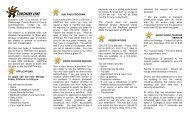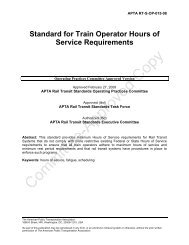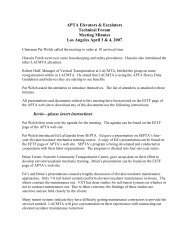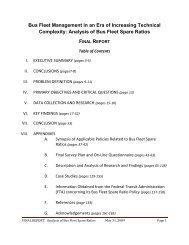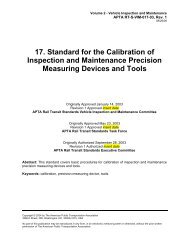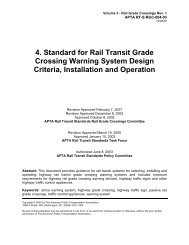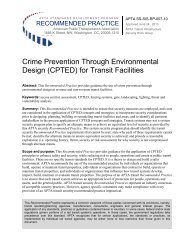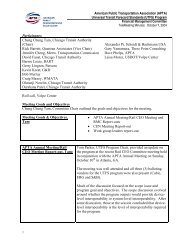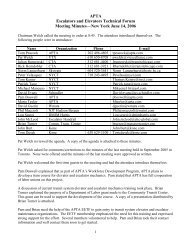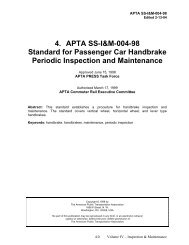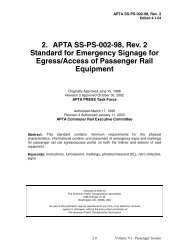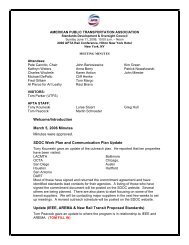Standard Bus Procurement Guidelines - APTAStandards.com
Standard Bus Procurement Guidelines - APTAStandards.com
Standard Bus Procurement Guidelines - APTAStandards.com
You also want an ePaper? Increase the reach of your titles
YUMPU automatically turns print PDFs into web optimized ePapers that Google loves.
<strong>Standard</strong> <strong>Bus</strong> <strong>Procurement</strong> <strong>Guidelines</strong><br />
5.3.4.3 AIR LINES AND FITTINGS<br />
Air lines, except necessary flexible lines, shall conform to the installation and material requirements of<br />
SAE <strong>Standard</strong> J1149 for copper tubing with standard, brass, flared or ball sleeve fittings, or SAE<br />
<strong>Standard</strong> J844 for nylon tubing if not subject to temperatures over 200 degrees F. Nylon tubing shall be<br />
installed in accordance with the following color-coding standards:<br />
Green. Indicates primary brakes and supply<br />
Red. Indicates secondary brakes<br />
Brown. Indicates parking brake<br />
Yellow. Indicates <strong>com</strong>pressor governor signal<br />
Black. Indicates accessories<br />
Line supports shall prevent movement, flexing, tension strain, and vibration. Copper lines shall be<br />
supported by looms to prevent the lines from touching one another or any <strong>com</strong>ponent of the bus. To the<br />
extent practicable and before installation, the lines shall be pre-bent on a fixture that prevents tube<br />
flattening or excessive local strain. Copper lines shall be bent only once at any point, including prebending<br />
and installation. Rigid lines shall be supported at no more than 5-foot intervals. Nylon lines<br />
may be grouped and shall be continuously supported.<br />
The <strong>com</strong>pressor discharge line between power plant and body-mounted equipment shall be flexible<br />
convoluted copper or stainless steel line, or may be flexible Teflon hose with a braided stainless steel<br />
jacket. Other lines necessary to maintain system reliability shall be flexible Teflon hose with a braided<br />
stainless steel jacket. End fittings shall be standard SAE or JIC brass or steel, flanged, swivel type<br />
fittings. Flexible hoses shall be as short as practicable and individually supported. They shall not touch<br />
one another or any part of the bus except for the supporting grommets. Flexible lines shall be supported<br />
at 2-foot intervals or less.<br />
Air lines shall be cleaned and blown out before installation and shall be installed to minimize air leaks.<br />
All air lines shall be sloped toward a reservoir and routed to prevent water traps. Grommets shall protect<br />
the air lines at all points where they pass through understructure <strong>com</strong>ponents.<br />
5.3.4.4 AIR RESERVOIRS<br />
All air reservoirs shall meet the requirements of FMVSS <strong>Standard</strong> 121-Section 5.1.2.1. and SAE<br />
<strong>Standard</strong> J10 and shall be equipped with 2 inch minimum clean-out plugs and guarded or flush type<br />
drain valves. Major structural members shall protect these valves and any automatic moisture ejector<br />
valves from road hazards. Reservoirs shall be sloped toward the drain valve. All air reservoirs shall<br />
have brass drain valves which discharge below floor level with lines routed to eliminate the possibility of<br />
water traps and/or freezing in the drain line.<br />
5.3.4.5 AIR SYSTEM DRYER<br />
An air dryer shall prevent accumulation of moisture and oil in the air system. The air dryer system will<br />
include a replaceable desiccant bed, electrically heated drain, and activation device. A 2M/3M mechanic<br />
shall replace the desiccant in less than 15 minutes.<br />
Technical Specifications 146 10/18/07



